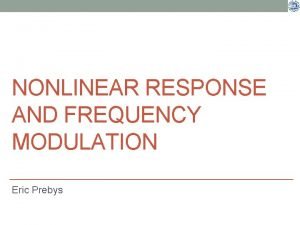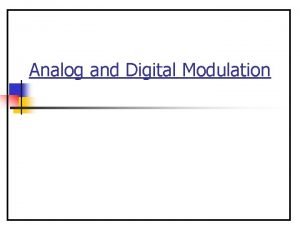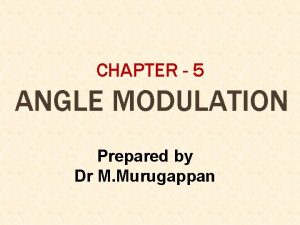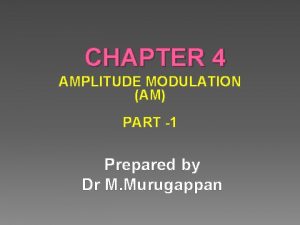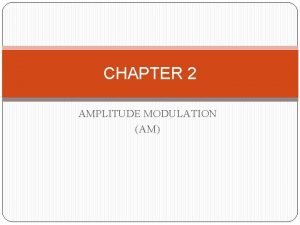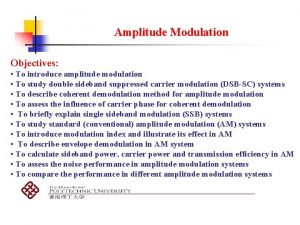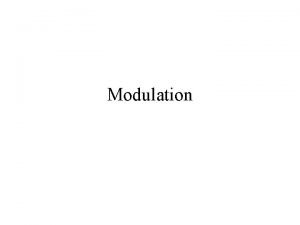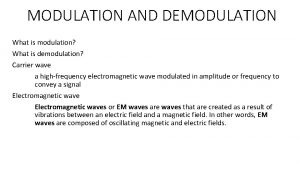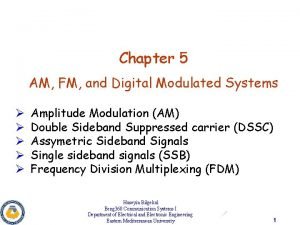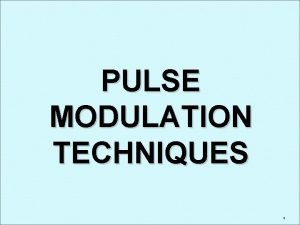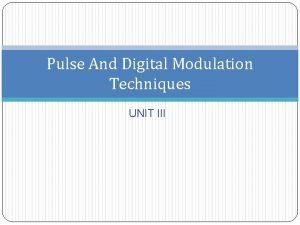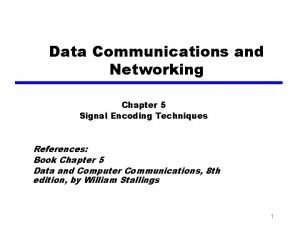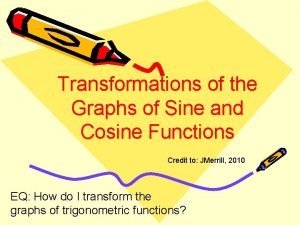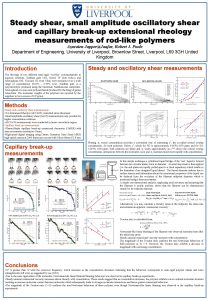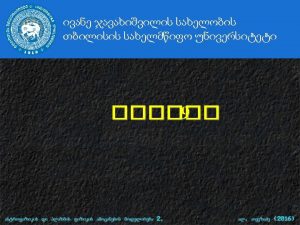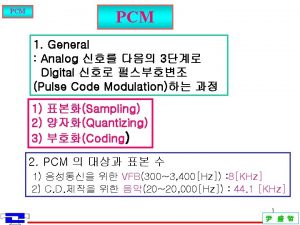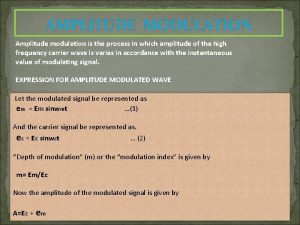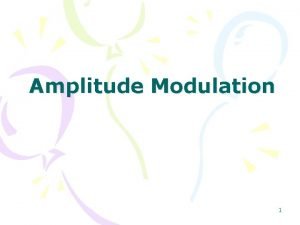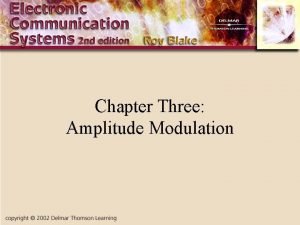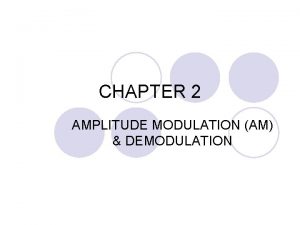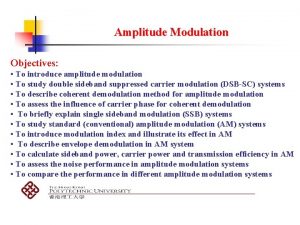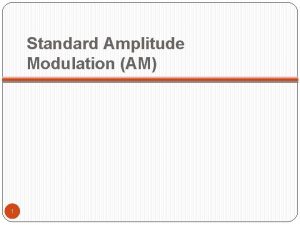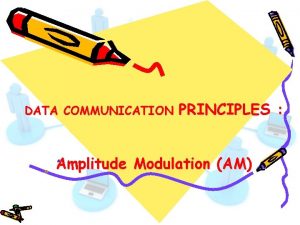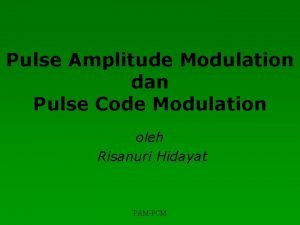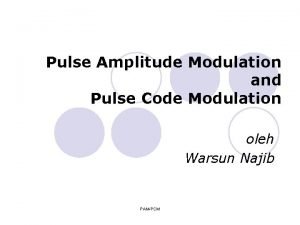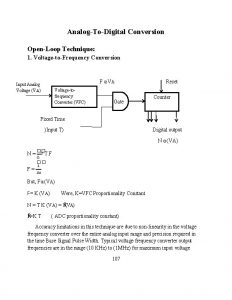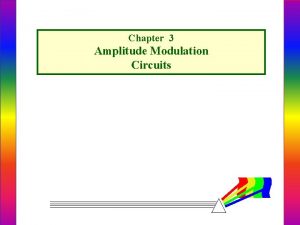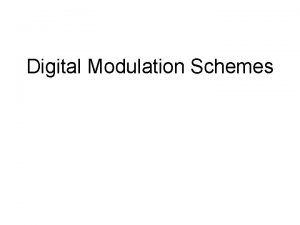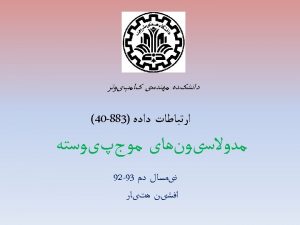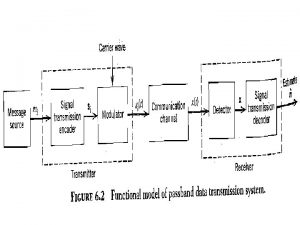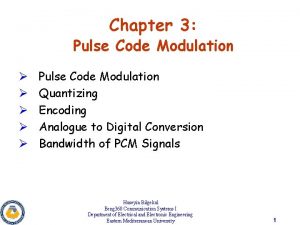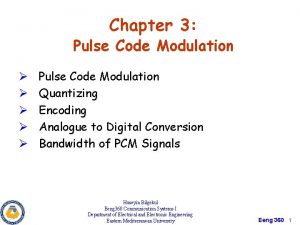AnalogtoDigital Conversion PAMPulse Amplitude Modulation PCMPulse Code Modulation























- Slides: 23

Analog-to-Digital Conversion PAM(Pulse Amplitude Modulation) PCM(Pulse Code Modulation)

PAM(Pulse Amplitude Modulation) n n Conversion of analog signal to a pulse type signal where the amplitude of signal denotes the analog information Two class of PAM signals n Natural sampling (gating) n n Easier to generate Instantaneous sampling n n Flat-top pulse More useful to conversion to PCM

PAM with natural sampling W(t) Ws(t) t t S(t) Analog bilateral switch Ts Ws(t) =W(t)S(t) W(t) t Duty Cycle D= /Ts=1/3 S(t)

Spectrum of PAM with natural sampling n n |W(f)| Spectrum of input analog signal Spectrum of PAM n n 1 D=1/3, fs=4 B BT= 3 fs = 12 B f -B B |Ws(f)| D=1/3 -3 fs -2 fs -B B fs 2 fs 3 fs

PAM with flat-top sampling W(t) Ws(t) t t S(t) Ts t Sample and Hold

Spectrum of PAM with flat-top sampling n n |W(f)| Spectrum of Input Spectrum of PAM n n 1 /Ts=1/3, fs=4 B BT= 3 fs = 12 B f -B B |Ws(f)| D=1/3 -3 fs -2 fs -B B fs 2 fs 3 fs

Summary of PAM n n Require very wide bandwidth Bad noise performance n n n Not good for long distance transmission Provide means for converting a analog signal to PCM signal Provide means for TDM(Time Division Multiplexing) n Information from different source can be interleaved to transmit all of the information over a single channel

PCM(Pulse Code Modulation) n Definition n n PCM is essentially analog to digital conversion of a signal type where the information contained in the instantaneous samples of an analog signal is represented by digital words in a serial bit stream Analog signal is first sampled at a rate higher than Nyquist rate, and then samples are quantized n n Uniform PCM : Equal quantization interval Nonuniform PCM : Unequal quantization interval

Why PCM is so popular ? n n PCM requires much wider bandwidth But, n n n Inexpensive digital circuitry PCM signal from analog sources(audio, video, etc. ) may be merged with data signals(from digital computer) and transmitted over a common high-speed digital communication system (This is TDM) Regeneration of clean PCM waveform using repeater. n n But, noise at the input may cause bit errors in regenerated PCM output signal The noise performance is superior than that of analog system.

PCM transmitter/receiver Analog signal LPF BW=B Bandlimited Analog signal PCM signal Encoder Sampler & Hold Quantized PAM signal Flat-top PAM signal Quantizer No. of levels=M Channel, Telephone lines with regenerative repeater PCM signal Decoder Quantized PAM signal Reconstruction LPF Analog Signal output

Waveforms in PCM Uniform quantizer Error signals Waveform of signals PCM signal PCM word

Encoder n Usually Gray code is used n n Only one bit change for each step change in quantized level Single errors in received PCM code word will cause minimum error if sign bit is not changed In text, NBC(Natural Binary Coding) is used Multilevel signal can be used n Much smaller bandwidth than binary signals

Uniform PCM n Let M=2 n is large enough Uniform distribution =2 Xmax/M Xmax x Distortion -Xmax - /2 x

SQNR of PCM n Distortion n n SQNR n Let normalized input : n n n

Bandwidth of PCM n n Hard to analyze because PCM is nonlinear Bandwidth of PCM n If sinc function is used to generate PCM n n If rectangular pulse is used n n , where R is bit rate , first null bandwidth If fs=2 B (Nyquist sampling rate) n n Lower bound of BW: In practice, is closer to reality

Performance of PCM Quantizer Level, M 2 4 8 16 32 64 128 256 512 1024 2048 4096 8192 16384 32768 65536 n bits M=2 n 1 2 3 4 5 6 7 8 9 10 11 12 13 14 15 16 Bandwidth >n. B 2 B 4 B 6 B 8 B 10 B 12 B 14 B 16 B 18 B 20 B 22 B 24 B 26 B 28 B 30 B 32 B SQNR|d. B_PK 4. 8+6 n 10. 8 16. 8 22. 8 28. 9 34. 9 40. 9 46. 9 52. 9 59. 0 65. 0 71. 0 77. 0 83. 0 89. 1 95. 1 101. 1

PCM examples n Telephone communication n Voice frequency : 300 ~ 3400 Hz n n n Encoding with 7 information bits + 1 parity bit n n n Bit rate of PCM : R = fs x n = 8 K x 8 = 64 Kbits/s Buad rate = 64 Ksymbols/s = 64 Kbps Required Bandwidth of PCM n n n Minimum sampling frequency = 2 x 3. 4 KHz = 6. 8 KHz In US, fs = 8 KHz is standard If sinc function is used: B > R/2 = 32 KHz If rectangular is used: B = R = 64 KHz SQNR|d. B_PK = 46. 9 d. B (M = 27) n Parity does not affect quantizing noise but decrease errors caused by channels

PCM examples n CD (Compact Disk) n For each stereo channel n n 16 bit PCM word Sampling rate of 44. 1 KHz Reed-Solomon coding with interleaving to correct burst errors caused by scratches and fingerprints on CD High quality than telephone communication

Homework n Illustrative Problems n n 4. 9, 4. 10, 4. 11, 4. 12 Problems n 4. 14

Nonuniform quantization n Example: Voice analog signal n n Peak value(1 V) is less appears while weak value(0. 1 V, 20 d. B down) around 0 is more appears (nonuniform amplitude distribution) Thus nonuniform quantization is used Implementation of nonuniform Compression PCM with quantization Analog PCM n Input (Nonlinear) filter Uniform Quantization output

Nonuniform Quantization n Two types according to compression filter n -law : used in US n n n See Figure 4. 9, Page 155 A-law : used in Europe n

Nonuniform Quantization n Compandor = Compressor + Expandor n n Compressor: Compression filter in transmitter Expander: Inverse Compression filter in receiver n n -law : SQNR n n n Uniform quantizing: -law:

Homework n Illustrative Problems n n 4. 13, 4. 14 Problems n 4. 17
 Amplitude modulation vs frequency modulation
Amplitude modulation vs frequency modulation Amplitude modulation vs frequency modulation
Amplitude modulation vs frequency modulation Advantages of angle modulation
Advantages of angle modulation Dscfc
Dscfc Principle of amplitude modulation
Principle of amplitude modulation Amplitude modulation conclusion
Amplitude modulation conclusion Unintellegible
Unintellegible Define modulation and demodulation
Define modulation and demodulation Disadvantages of analog signal
Disadvantages of analog signal Amplitude modulation
Amplitude modulation Busceral
Busceral Granular noise occurs when
Granular noise occurs when Pulse code modulation and demodulation
Pulse code modulation and demodulation Pulse code modulation and demodulation
Pulse code modulation and demodulation Pulse code modulation conclusion
Pulse code modulation conclusion Hirst
Hirst Mechanical waves and electromagnetic waves similarities
Mechanical waves and electromagnetic waves similarities Amplitude wavelength and frequency
Amplitude wavelength and frequency Cos graph transformations
Cos graph transformations Tipos de climas quentes
Tipos de climas quentes Small amplitude oscillatory shear
Small amplitude oscillatory shear Small amplitude wave
Small amplitude wave Quasi static testing
Quasi static testing Ecological amplitude definition
Ecological amplitude definition
